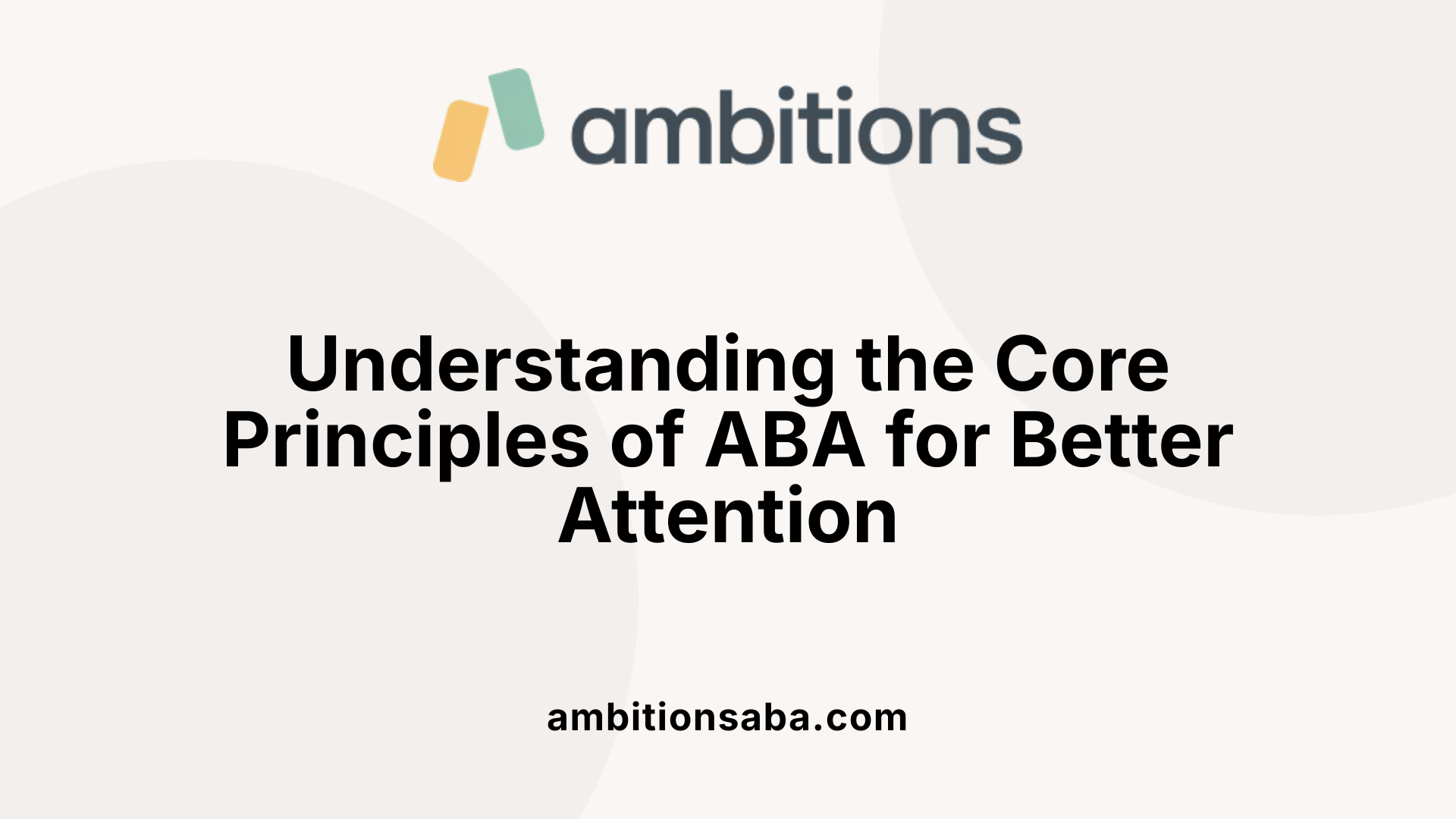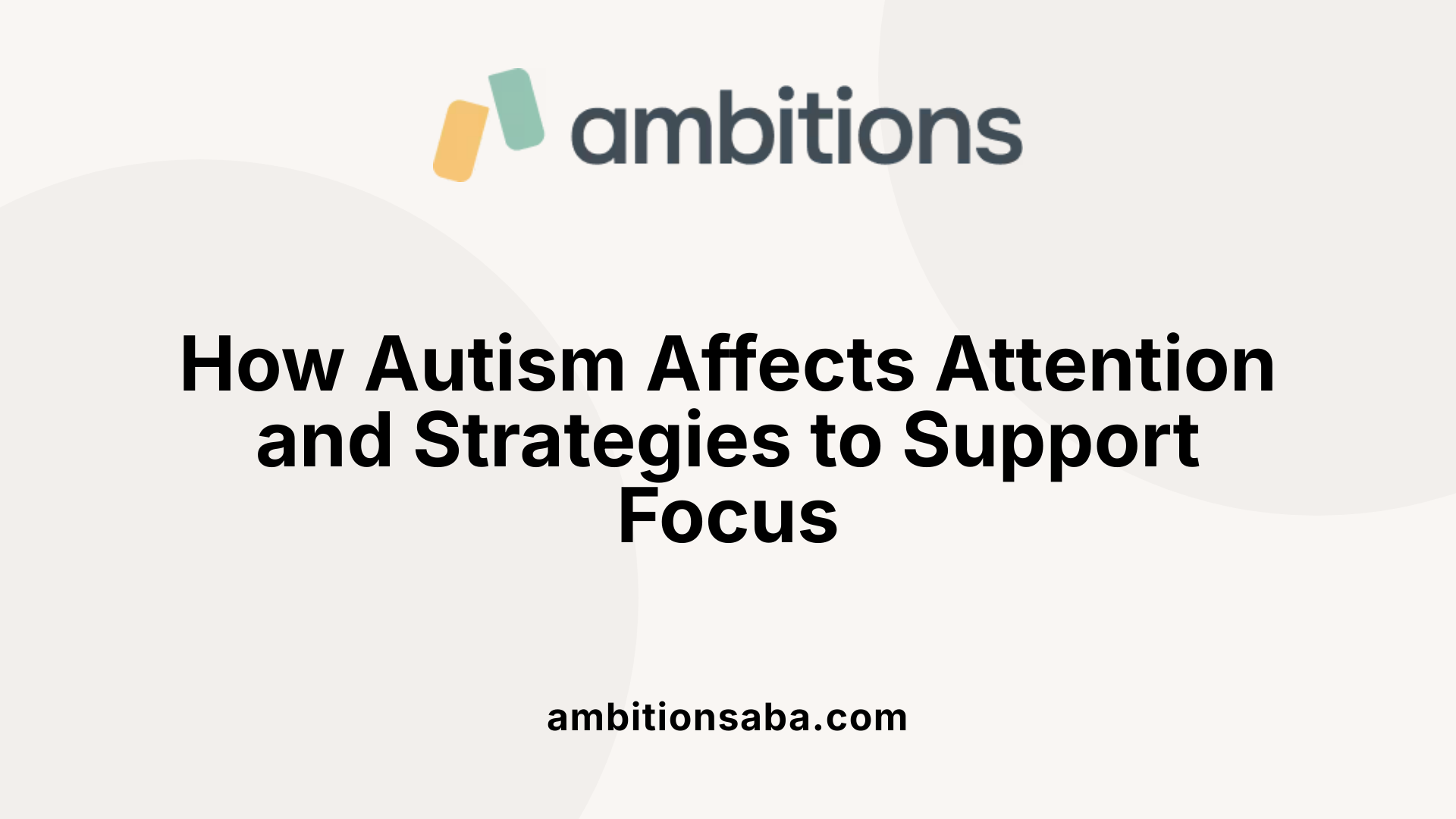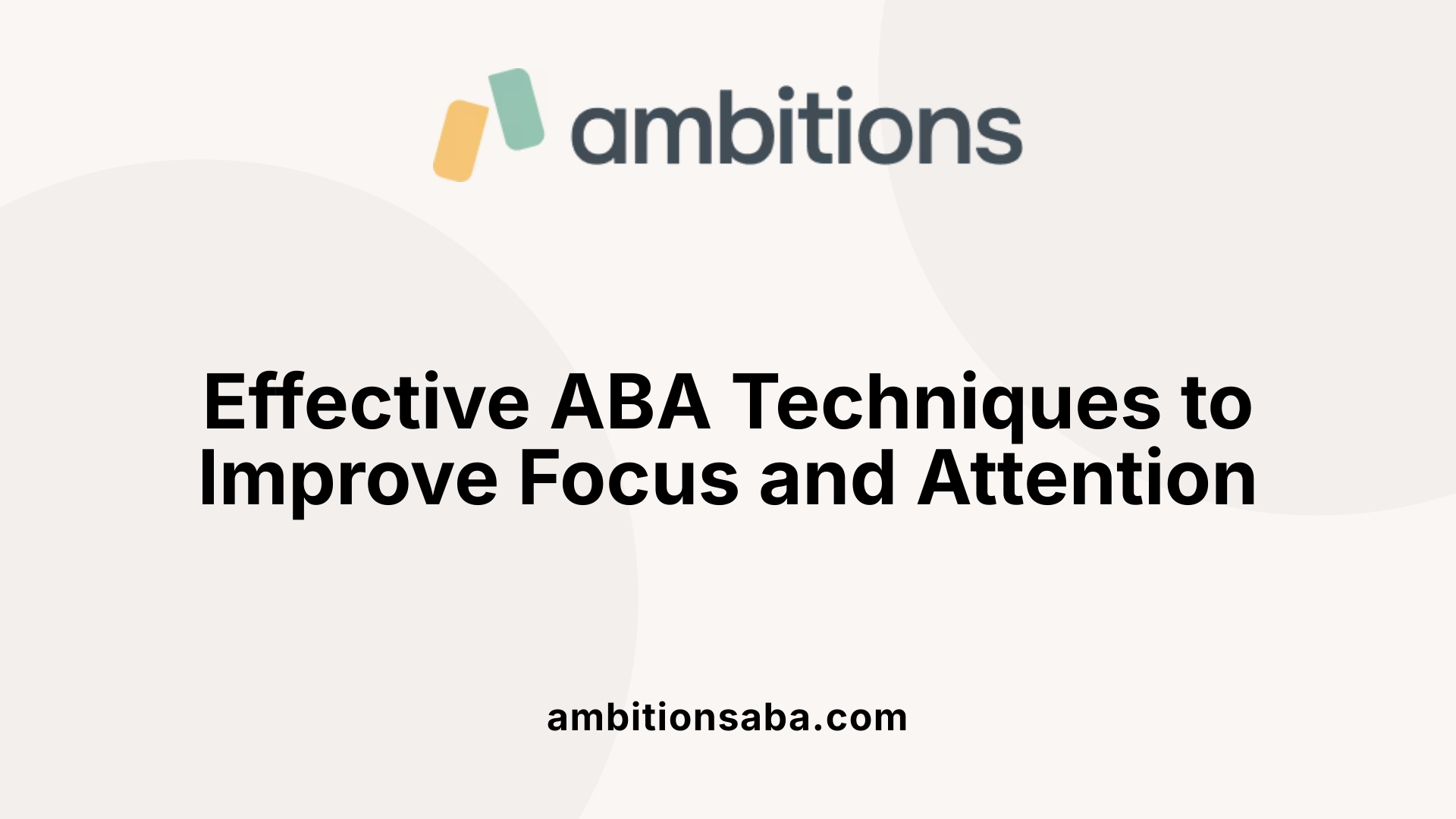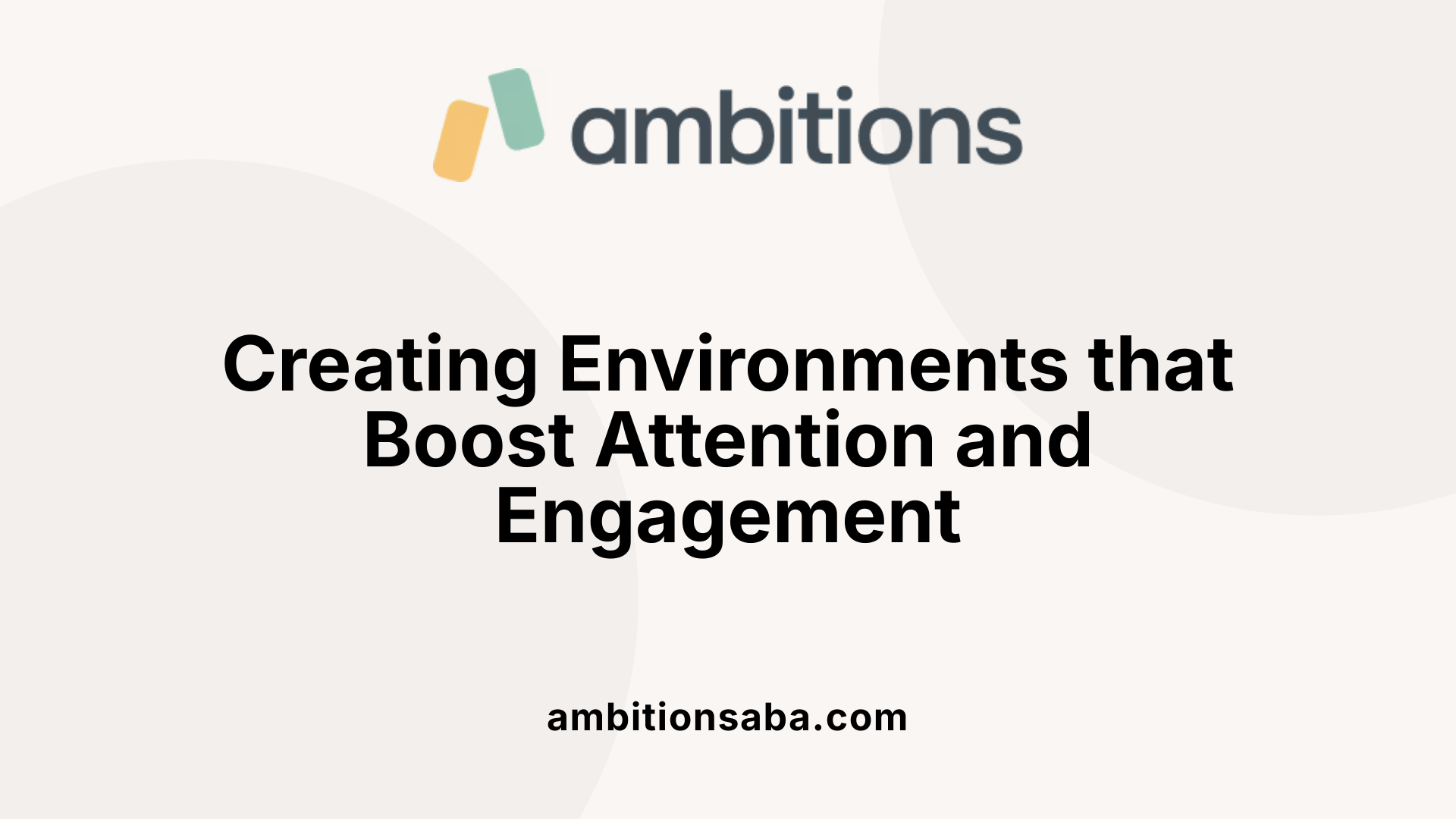Understanding Attention Challenges in Autism and the Role of ABA
Autism Spectrum Disorder (ASD) presents unique challenges in attention and focus, significantly impacting learning, social interaction, and daily functioning. This article explores how applied behavior analysis (ABA), a scientifically supported therapeutic approach, effectively addresses these issues by employing evidence-based strategies that enhance concentration, reduce distractibility, and promote adaptive skills in individuals with autism.
Core Principles of ABA and Their Relation to Attention and Focus

What are the core principles of ABA therapy, and how do they relate to improving attention and focus?
Applied Behavior Analysis (ABA) is built on several fundamental strategies that work together to improve attention and focus in children with autism. These principles include reinforcement, functional behavior assessment, prompting and fading, shaping, modeling, and task analysis.
Reinforcement plays a central role by rewarding desired behaviors, such as sustained attention or task completion, which encourages the child to repeat these behaviors. Positive reinforcement—like praise or tangible rewards—helps the child learn to focus longer and stay engaged.
Functional behavior assessment involves understanding why a particular behavior occurs, enabling tailored interventions. By identifying triggers or functions behind attention difficulties, therapists can modify activities to better suit the child's needs.
Prompting and fading are used to guide the child towards desired behaviors initially and gradually reduce assistance as independence increases. This method helps children develop focused attention without reliance on prompts.
Shaping involves reinforcing successive approximations toward the target behavior, which gradually enhances attention span and task persistence.
Modeling demonstrates appropriate attention and focus behaviors for children to imitate, enabling them to learn through observation.
Task analysis breaks down complex tasks into small, manageable steps, making it easier for children to concentrate and complete activities effectively.
These core strategies are often employed in naturalistic settings with engaging activities like matching games, storytelling, or arts and crafts. The use of visual supports and sensory-friendly environments further supports focus.
Overall, ABA’s evidence-based approaches systematically teach and reinforce attentive behaviors. They promote sustained engagement, reduce distractibility, and build skills for broader social and academic success.
| Principle | Description | How It Enhances Attention and Focus |
|---|---|---|
| Reinforcement | Rewards for desired behaviors | Motivates children to maintain focus and complete tasks |
| Functional Behavior Assessment | Analyzing behavior function to tailor interventions | Addresses specific attention challenges effectively |
| Prompting and Fading | Guided assistance gradually withdrawn | Supports learning attention skills without dependency |
| Shaping | Reinforcing small steps toward a goal | Builds endurance for longer focus durations |
| Modeling | Demonstrating desired actions | Encourages imitation of attentive behaviors |
| Task Analysis | Breaking tasks into manageable steps | Simplifies complex tasks making it easier to concentrate |
By integrating these strategies, ABA provides a structured framework that helps children develop better attention span and focus, essential for their learning and social integration.
The Impact of Autism on Attention and Focus

How does autism typically affect attention and focus, and in what ways can ABA therapy help improve these skills?
Children with autism often face challenges related to attention and focus. They may experience sensory overload due to sensitivities to bright lights, loud sounds, and other sensory inputs, which can distract them and make concentrating difficult. This overload can lead to difficulty in maintaining focus on tasks, especially in noisy or unstructured environments.
Additionally, children with autism frequently have shorter attention spans, which makes it hard for them to initiate or complete tasks that require prolonged concentration. Fatigue and sensory sensitivities further impair their ability to stay engaged over time.
Another characteristic is having intense interests in specific topics. While this can help them focus deeply on those interests, it can also cause them to ignore other important activities, affecting their overall attention distribution.
Neurobiological differences in the brain, such as variations in brain structure and neurotransmitter levels like dopamine, are believed to influence these attention difficulties. These neurological factors contribute to challenges such as filtering distractions and switching between tasks.
Applied Behavior Analysis (ABA) therapy offers effective strategies to address these attention issues. Through structured techniques—including task analysis, reinforcement systems, prompting, and redirection—ABA helps children learn to focus and increase their attention span. Reinforcement encourages the repetition of desired behaviors, gradually building their ability to concentrate longer. Using visual supports, sensory breaks, and environment modifications also make it easier for children with autism to stay engaged.
Research confirms that ABA significantly improves social, communication, and behavioral skills, enabling children to participate more fully in daily activities. By shaping attention and focus skills, ABA supports children in managing distractions, completing tasks, and developing independence, ultimately enhancing their learning and social interactions.
Strategies and Techniques of ABA for Enhancing Attention and Focus

How does ABA therapy impact attention and focus in children with autism?
ABA (Applied Behavior Analysis) therapy plays a significant role in improving attention and focus among children with autism. It employs a variety of structured teaching techniques tailored to each child's needs. For example, task analysis breaks down complex tasks into manageable steps, making it easier for children to concentrate on one part at a time.
Reinforcement strategies, such as praise or small rewards, motivate children to remain engaged in tasks for longer periods. Prompting and redirection help guide children back to focus when they become distracted or disengaged. As a result, children learn to filter sensory input, reduce disruptive behaviors, and enhance their ability to sustain attention.
Research and meta-analyses support the effectiveness of ABA interventions, showing that many children experience notable progress in attention, communication, and daily functioning. Continuous monitoring allows practitioners to adjust strategies as needed, ensuring each child receives personalized support.
ABA methods are versatile and can be adapted for children with attention challenges related to other conditions like ADHD. Overall, ABA fosters improved focus, better social participation, and greater independence in children with autism.
Scientific Evidence Supporting ABA's Effectiveness in Attention Improvement
What scientific evidence supports the effectiveness of ABA therapy in improving attention and focus for individuals with autism?
Research and systematic reviews have established that ABA therapy can significantly enhance attention and focus in children and adults with autism. Multiple studies published in reputable journals such as Pediatrics and the Journal of Autism and Developmental Disorders demonstrate that intensive ABA interventions lead to substantial improvements not only in behavioral issues but also in cognitive skills like IQ, communication, and everyday adaptive behaviors.
Meta-analyses reveal that participants undergoing ABA often show increased ability to concentrate on tasks, sustain attention for longer periods, and manage distractions better. These improvements are linked to the structured, reinforcement-based nature of ABA therapies, which incorporate techniques like discrete trial training, Pivotal Response Treatment, and naturalistic, play-based methods.
Early intervention plays a crucial role, as studies suggest that initiating ABA therapy during early childhood exploits the brain's neuroplasticity, resulting in more pronounced and lasting gains in focus and attention. Because ABA techniques can be tailored to individual needs and often include engaging, play-oriented activities, children are more motivated to participate and stay attentive.
Overall, scientific research confirms that ABA is an effective approach to help individuals with autism develop better attention skills, aiding their overall learning, social participation, and independence.
The Role of Sensory Processing in Attention Challenges
How does sensory processing influence attention and focus in children with autism, and what strategies can improve their focus?
Children with autism often experience heightened sensitivities to sensory input, such as bright lights, loud sounds, or certain textures. Research by Ayelet Ben-Sasson at Haifa University indicates that between 70 to 96 percent of children on the autism spectrum face challenges related to sensory processing. These sensitivities can cause sensory overload, which distracts children and hampers their ability to concentrate on tasks.
Sensory overload occurs when the brain receives more sensory information than it can process comfortably. For children with autism, this can lead to feelings of stress or discomfort, causing momentary or prolonged distraction. As a result, maintaining sustained attention becomes difficult, especially in unstructured or overstimulating environments.
To help improve focus, various strategies are used. Creating sensory-friendly environments is essential; this involves establishing calm, quiet spaces where children can retreat if they feel overwhelmed. Tools like weighted blankets and fidget toys are effective in providing calming sensory input and promoting self-regulation.
Implementing sensory breaks during tasks or activities allows children to reset their sensory systems. These breaks might include physical movement, deep pressure activities, or quiet time, helping children regain their focus.
Overall, understanding sensory processing differences is crucial for developing supportive environments and tools. These methods significantly enhance the capacity of children with autism to concentrate, participate fully in learning and social interactions, and reduce frustration caused by sensory overload.
Creating Supportive Environments and Practical Strategies to Maximize Focus

What strategies and environments are effective in helping individuals with autism improve their attention and focus?
Enhancing attention in children and adults with autism involves creating supportive settings that accommodate sensory and behavioral needs. Structured routines and visual supports are foundational because they provide predictability and clarity. Visual schedules, for example, break down daily activities into manageable steps, reducing anxiety and helping individuals understand what to expect next. Clear prompts and cues guide their actions, making transitions smoother and tasks easier to initiate.
Sensory-friendly spaces also play a vital role. These include calm zones with soft lighting, minimal noise, and calming textures. Incorporating sensory tools like weighted blankets, fidget toys, or sound-muffling headphones can support regulation. Regular sensory breaks involving physical activity—such as obstacle courses, stretching, or deep pressure activities—help release pent-up energy and refocus attention.
Physical movement is especially useful, as it can increase alertness and reduce hyperactivity. Activities like jumping jacks or relaxed stretches provide needed physical outlets that improve concentration.
Most importantly, strategies should be personalized. Each individual has unique sensory sensitivities and attention thresholds. Tailoring environments and routines to these needs ensures maximum engagement and minimizes distractions.
In practical terms, these approaches are effective in various settings, including homes, schools, and therapy centers. By combining structure, sensory regulation, and movement with customized plans, caregivers and practitioners can significantly improve focus and support the child's learning and social participation.
Harnessing the Power of ABA for Better Attention and Engagement
ABA therapy, supported by extensive scientific research and tailored strategies, offers a powerful means to enhance attention and focus in children with autism. By systematically reinforcing desirable behaviors, utilizing sensory-friendly environments, and employing naturalistic, play-based interventions, ABA empowers individuals to develop meaningful, long-lasting attention skills. As understanding of autism’s neurobiological underpinnings deepens, ABA continues to evolve, ensuring that each person receives personalized support to thrive socially, academically, and in daily life.
References
- How Autism Affects Focus and Attention - Steady Steps ABA
- Can Autism Make It Hard to Focus? | Blue Jay ABA
- The effectiveness of applied behavior analysis program training on ...
- Improving Attention Span in Autism Through School Readiness ...
- The Controversy Around ABA - Child Mind Institute
- Effective Strategies for Autism & Attention Span Improvement
- How ABA Therapy Helps Children with Behavioral Challenges



